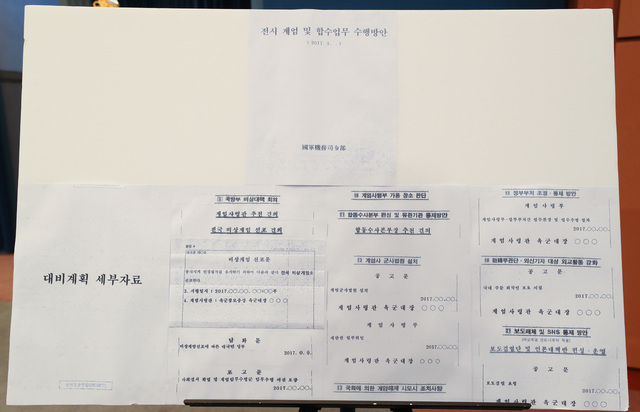 |
|
Blue House spokesperson Kim Eui-kyum discloses outlines of the “Specifics of the Provisional Plan,” which was part of the DSC’s “Wartime Martial Law and Joint Investigation Plan,” at the Blue House’s Chunchugwan (Spring and Autumn Pavilion) on July 20. (Kim Jung-hyo, staff photographer)
|
Evidence increasingly points to deliberate plans as opposed to preemptive measures
Another document has emerged from the South Korean military’s Defense Security Command (DSC) that details how martial law would have been instituted in the event that former president Park Geun-hye’s impeachment had been overturned by the Constitutional Court in Mar. 2017. Contradicting the explanation given by former Defense Minister Han Min-goo that the army had only “considered” the possibility of rioting, this incendiary document contains very specific measures for deploying armored vehicles and tanks to the Seoul neighborhoods of Gwanghwamun and Yeouido and controlling the National Assembly and the press. During a briefing on July 20, Blue House spokesperson Kim Eui-kyum disclosed the broad strokes of the “Specifics of the Contingency Plan,” which was part of the “Wartime Martial Law and Joint Investigation Plan” composed by the DSC. This 67-page document consists of 21 points under the four major sections of a “phase-by-phase countermeasures,” “garrison decree,” “declaration of martial law” and “carrying out martial law.” The document essentially lays out a plan for carrying out the martial law decree that was reviewed in the document that Democratic Party lawmaker Rep. Lee Cheol-hui released on July 5. “It says that the key to successfully instituting martial law is taking preemptive measures, such as swiftly declaring martial law while maintaining security and having martial law troops take control of crucial junctures,” Kim said when asked about the details of the document. “The declarations of martial law and emergency-level martial law were already written [in the document]. It included a recommendation for the army chief of staff to be placed in command of the martial law forces rather than the chairman of the joint chiefs, as army regulations state, and the results of reviewing that recommendation,” Kim explained. “What this says is completely different from the Joint Chiefs of Staff’s practical handbook for martial law, which contains the regulations for activating an ordinary martial law decree,” he added. This strongly suggests that these were not ordinary military guidelines about a hypothetical situation but a plan proposed on the assumption that it would be carried out.
 |
|
Blue House spokesperson Kim Eui-kyum publicly revealed some of the contents of the “Specifics of the Contingency Plan,” part of the DSC’s “Wartime Martial Law and Joint Investigation Plan,” on July 20. In the event that the Constitutional Court had overturned the impeachment of then president Park Geun-hye, the plan contains specific measures for deploying armored vehicles and tanks to the Seoul neighborhoods of Gwanghwamun and Yeouido and controlling the National Assembly and the press. (Kim Jung-hyo, staff photographer)
|







